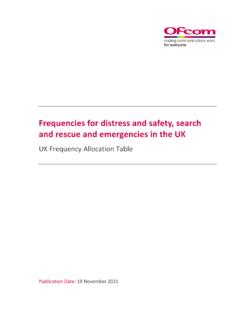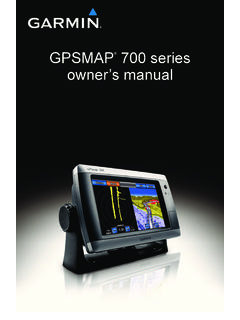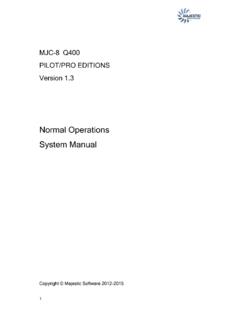Transcription of FOREWORD - Australian Maritime Safety Authority
1 Australian Global Maritime Distress and Safety System (GMDSS) Handbook 2018 iFOREWORDThis handbook has been produced by the Australian Maritime Safety Authority (AMSA), and is intended for use on ships that are: compulsorily equipped with GMDSS radiocommunication installations in accordance with the requirements of the International Convention for the Safety of Life at Sea Convention 1974 (SOLAS) and Commonwealth or State government marine legislation voluntarily equipped with GMDSS radiocommunication is the recommended textbook for candidates wishing to qualify for the Australian GMDSS General Operator s Certificate of handbook replaces the tenth edition of the GMDSS Handbook published in September 2013, and has been amended to reflect.
2 Changes to regulations adopted by the International Telecommunication Union (ITU) World Radiocommunications Conference (2015) changes to Inmarsat services an updated AMSA distress beacon registration form changes to various ITU Recommendations changes to the publications published by the ITU developments in Man Overboard (MOB) devices clarification of GMDSS radio log procedures general editorial updating and outlined in the handbook are based on the ITU Radio Regulations, on radio procedures used by Australian Maritime Communications Stations and Satellite Earth Stations in the Inmarsat observance of the procedures covered by this handbook is essential for the efficient exchange of communications in the marine radiocommunication service, particularly where Safety of life at sea is concerned.
3 Special attention should be given to those sections dealing with distress, urgency, and of radiocommunications equipment on vessels not equipped with GMDSS installations should refer to the Marine Radio Operators Handbook published by the Australian Maritime College, Launceston, Tasmania, provision of this handbook or the ITU Radio Regulations prevents the use, by a ship in distress, of any means at its disposal to attract attention, make known its position and obtain , no provision of this handbook or the ITU Radio Regulations prevents the use, by ships engaged in search and rescue operations, of any means at their disposal to assist a ship in the purposes of this handbook, references to distress and Safety communications include distress, urgency and Safety calls and messages, including alerts and announcements promulgated by digital selective acknowledges the assistance of Inmarsat and the Bureau of Meteorology for reviewing relevant parts of the EditionJanuary 2018 ISBN: 978-0-9806416-8-4 This work is copyright.
4 Apart from any use as permitted under the Copyright Act 1968, no part may be reproduced by any process without prior written permission from the Australian Maritime Safety Authority (AMSA).Requests and inquiries concerning reproduction and rights should be addressed to the Manager Communication, AMSA, GPO Box 2181, Canberra ACT Australian Global Maritime Distress and Safety System (GMDSS) Handbook 2018 CONTENTSF oreword 1 An Introduction to the Global Maritime Distress And Safety System History Function requirements Basic concept of the GMDSS Areas of operation under the GMDSS The GMDSS Master Plan Introduction of GMDSS Functional requirements 32 General Principles and Features of the Maritime Mobile Service Priorities of communications in the Maritime Mobile Service Types of stations in the Maritime Mobile Service Frequencies and frequency bands Frequencies allocated to the Maritime services Characteristics of frequencies
5 Component parts of marine radio equipment Modes of communication 123 Requirements of Maritime Mobile and Satellite Services Functional requirements of ship stations Equipment carriage requirements for SOLAS ships Equipment carriage requirements for Non-SOLAS ships Types of alerting from GMDSS ships Watchkeeping on distress frequencies Sources of energy of ship stations Means of ensuring availability of ship station equipment Operator qualifications Licences, Safety radio certificates, inspection and surveys Ship station identification 254 Introduction to the Inmarsat system and the Maritime Mobile Satellite Service Maritime satellite communications Types of stations in the Maritime Mobile Satellite Service 305 GMDSS Digital Selective Calling Equipment and Systems Introduction Purpose DSC shipborne equipment Call formats Maritime Mobile Service Identity (MMSI)
6 Types of DSC calls and how they are used Distress Alert attempts Frequency or channel for ongoing communications Cancellation of inadvertent distress alerts 366 Narrow Band Direct Printing Equipment and Systems Introduction Modes of transmission GMDSS applications NBDP equipment 38 Australian Global Maritime Distress and Safety System (GMDSS) Handbook 2018 iii7 GMDSS Inmarsat equipment Inmarsat-B/Fleet77 SESs Inmarsat-C SESs Inmarsat EGC receivers 438 Long Range Identification and Tracking (LRIT) LRIT conformance testing 479 GMDSS MF, HF and VHF equipment MF/HF transceivers VHF transceivers Watchkeeping receivers 5010 Emergency Position Indicating Radio Beacons (EPIRBS)
7 EPIRBS The Cospas-Sarsat system Australian and New Zealand Cospas-Sarsat ground segment Vessel identification and beacon registration Homing by search aircraft EPIRB requirements for GMDSS ships 406 MHz EPIRB operation Inadvertent activation of 406 MHz EPIRBs Servicing and testing of 406 MHz EPIRBs Termination of Inmarsat -E/E+ EPIRBs VHF DSC EPIRBs EPIRBs fitted with AIS burst transmitters 5911 Shipborne Automatic Identification System (AIS) What Is AIS? System description How it works Functionality and capability Message types and formats Display requirements AIS benefits AIS errors and drawbacks Destination code to be used in AIS Contribution of AIS Annual testing of AIS 6812 Survival craft radio equipment Search and Rescue Radar Transponders (SARTs) AIS-Search and Rescue Transmitters (AIS-SARTs) Portable survival craft VHF radiotelephone apparatus Maritime survivor locating systems (Man Overboard devices) 74iv Australian Global Maritime Distress and Safety System (GMDSS)
8 Handbook 201813 The Navtex system 77 Introduction Shipboard equipment 7814 Search and Rescue (SAR) Operations Shore based SAR network The IAMSAR manual On-Scene communications Locating and homing signals 8015 Ship Reporting Systems MASTREP The REEFREP system The AMVER system Other ship reporting systems 8216 GMDSS Distress Urgency and Safety Communications Procedures General General Inmarsat distress, urgency and Safety procedures Fleet77 SESs Inmarsat 505 emergency calling (Fleetbroadband) Inmarsat-C SESs General DSC distress, urgency and Safety procedures MF/VHF DSC and radiotelephone distress urgency and Safety procedures HF DSC procedures Australian DSC.
9 NBDP and R/T distress and Safety shore facilities Radiotelephony communications with non-GMDSS ship stations Protection of distress frequencies Medical transports Radiomedical advice Maritime assistance services 9917 Routine Testing General requirements VHF DSC systems MF/HF DSC systems Inmarsat-C equipment Emergency radio batteries 406 Mhz EPIRBs SARTs AIS-SARTs Summary of routine testing 10218 Battery Maintenance Battery requirements Types of batteries Lead-Acid batteries Care and maintenance of Lead-Acid batteries Alkaline batteries Battery hazards 108 Australian Global Maritime Distress and Safety System (GMDSS) Handbook 2018 v19 Equipment Maintenance 111 Antenna systems Radio equipment 11220 Routine Communications Procedures Radio records Service documents General routine communications procedures Radio Telex services Traffic charges Time signals Sample GMDSS Radio Log page 118 Appendices 1191.
10 Frequencies for use by GMDSS Ship Stations 1192. Promulgation of Maritime Safety Information 1213. Phonetic Alphabet and Figure Code 1274. Standard Marine Communication Phrases 1295. Maritime Identification Digits (MIDs) 1316. Australian GMDSS GOC Course 1377. Reserve Source of Energy 1478. Guidelines for Operational Use of Shipborne AIS 1559. Forms 17310. Table of Transmitting Frequencies in the VHF Maritime Mobile Band 18311. Routine Testing (Extract From GMDSS Radio Log) 18912.








